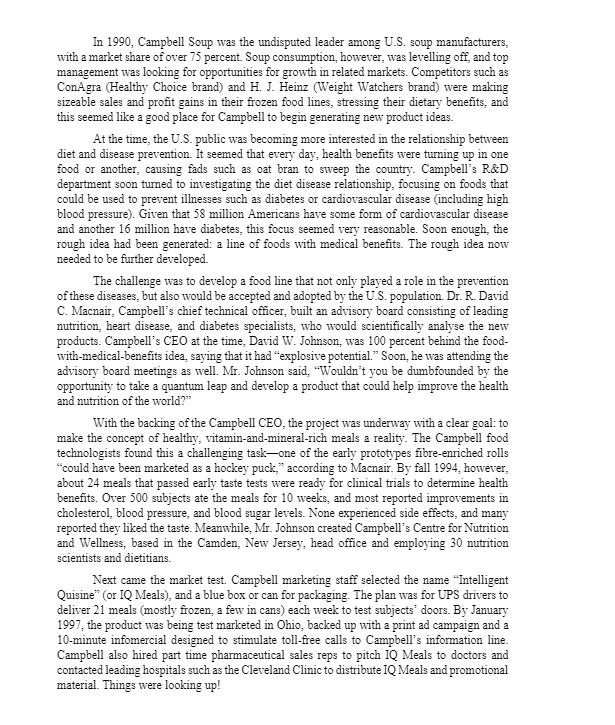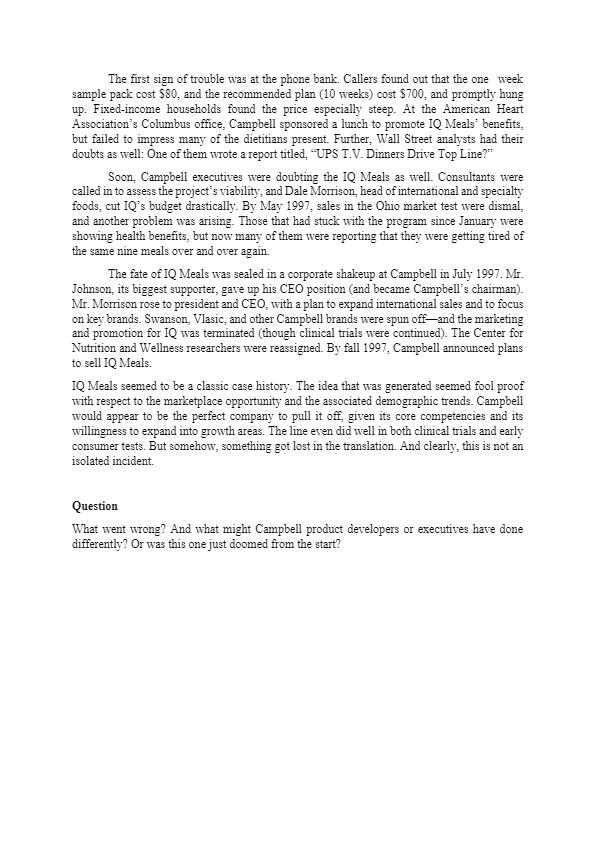Answered step by step
Verified Expert Solution
Question
1 Approved Answer
In 1990, Campbell Soup was the undisputed leader among U.S. soup manufacturers, with a market share of over 75 percent. Soup consumption, however, was


In 1990, Campbell Soup was the undisputed leader among U.S. soup manufacturers, with a market share of over 75 percent. Soup consumption, however, was levelling off, and top management was looking for opportunities for growth in related markets. Competitors such as ConAgra (Healthy Choice brand) and H. J. Heinz (Weight Watchers brand) were making sizeable sales and profit gains in their frozen food lines, stressing their dietary benefits, and this seemed like a good place for Campbell to begin generating new product ideas. At the time, the U.S. public was becoming more interested in the relationship between diet and disease prevention. It seemed that every day, health benefits were turning up in one food or another, causing fads such as oat bran to sweep the country. Campbell's R&D department soon turned to investigating the diet disease relationship, focusing on foods that could be used to prevent illnesses such as diabetes or cardiovascular disease (including high blood pressure). Given that 58 million Americans have some form of cardiovascular disease and another 16 million have diabetes, this focus seemed very reasonable. Soon enough, the rough idea had been generated: a line of foods with medical benefits. The rough idea now needed to be further developed. The challenge was to develop a food line that not only played a role in the prevention of these diseases, but also would be accepted and adopted by the U.S. population. Dr. R. David C. Macnair, Campbell's chief technical officer, built an advisory board consisting of leading nutrition, heart disease, and diabetes specialists, who would scientifically analyse the new products. Campbell's CEO at the time, David W. Johnson, was 100 percent behind the food- with-medical-benefits idea, saying that it had "explosive potential." Soon, he was attending the advisory board meetings as well. Mr. Johnson said, "Wouldn't you be dumbfounded by the opportunity to take a quantum leap and develop a product that could help improve the health and nutrition of the world?" With the backing of the Campbell CEO, the project was underway with a clear goal: to make the concept of healthy, vitamin-and-mineral-rich meals a reality. The Campbell food technologists found this a challenging task-one of the early prototypes fibre-enriched rolls "could have been marketed as a hockey puck," according to Macnair. By fall 1994, however, about 24 meals that passed early taste tests were ready for clinical trials to determine health benefits. Over 500 subjects ate the meals for 10 weeks, and most reported improvements in cholesterol, blood pressure, and blood sugar levels. None experienced side effects, and many reported they liked the taste. Meanwhile, Mr. Johnson created Campbell's Centre for Nutrition and Wellness, based in the Camden, New Jersey, head office and employing 30 nutrition scientists and dietitians. Next came the market test. Campbell marketing staff selected the name "Intelligent Quisine" (or IQ Meals), and a blue box or can for packaging. The plan was for UPS drivers to deliver 21 meals (mostly frozen, a few in cans) each week to test subjects' doors. By January 1997, the product was being test marketed in Ohio, backed up with a print ad campaign and a 10-minute infomercial designed to stimulate toll-free calls to Campbell's information line. Campbell also hired part time pharmaceutical sales reps to pitch IQ Meals to doctors and contacted leading hospitals such as the Cleveland Clinic to distribute IQ Meals and promotional material. Things were looking up! The first sign of trouble was at the phone bank. Callers found out that the one week sample pack cost $80, and the recommended plan (10 weeks) cost $700, and promptly hung up. Fixed-income households found the price especially steep. At the American Heart Association's Columbus office, Campbell sponsored a lunch to promote IQ Meals' benefits, but failed to impress many of the dietitians present. Further, Wall Street analysts had their doubts as well: One of them wrote a report titled, "UPS T.V. Dinners Drive Top Line?" Soon, Campbell executives were doubting the IQ Meals as well. Consultants were called in to assess the project's viability, and Dale Morrison, head of international and specialty foods, cut IQ's budget drastically. By May 1997, sales in the Ohio market test were dismal, and another problem was arising. Those that had stuck with the program since January were showing health benefits, but now many of them were reporting that they were getting tired of the same nine meals over and over again. The fate of IQ Meals was sealed in a corporate shakeup at Campbell in July 1997. Mr. Johnson, its biggest supporter, gave up his CEO position (and became Campbell's chairman). Mr. Morrison rose to president and CEO, with a plan to expand international sales and to focus on key brands. Swanson, Vlasic, and other Campbell brands were spun off-and the marketing and promotion for IQ was terminated (though clinical trials were continued). The Center for Nutrition and Wellness researchers were reassigned. By fall 1997, Campbell announced plans to sell IQ Meals. IQ Meals seemed to be a classic case history. The idea that was generated seemed fool proof with respect to the marketplace opportunity and the associated demographic trends. Campbell would appear to be the perfect company to pull it off, given its core competencies and its willingness to expand into growth areas. The line even did well in both clinical trials and early consumer tests. But somehow, something got lost in the translation. And clearly, this is not an isolated incident. Question What went wrong? And what might Campbell product developers or executives have done differently? Or was this one just doomed from the start?
Step by Step Solution
★★★★★
3.47 Rating (154 Votes )
There are 3 Steps involved in it
Step: 1

Get Instant Access to Expert-Tailored Solutions
See step-by-step solutions with expert insights and AI powered tools for academic success
Step: 2

Step: 3

Ace Your Homework with AI
Get the answers you need in no time with our AI-driven, step-by-step assistance
Get Started


